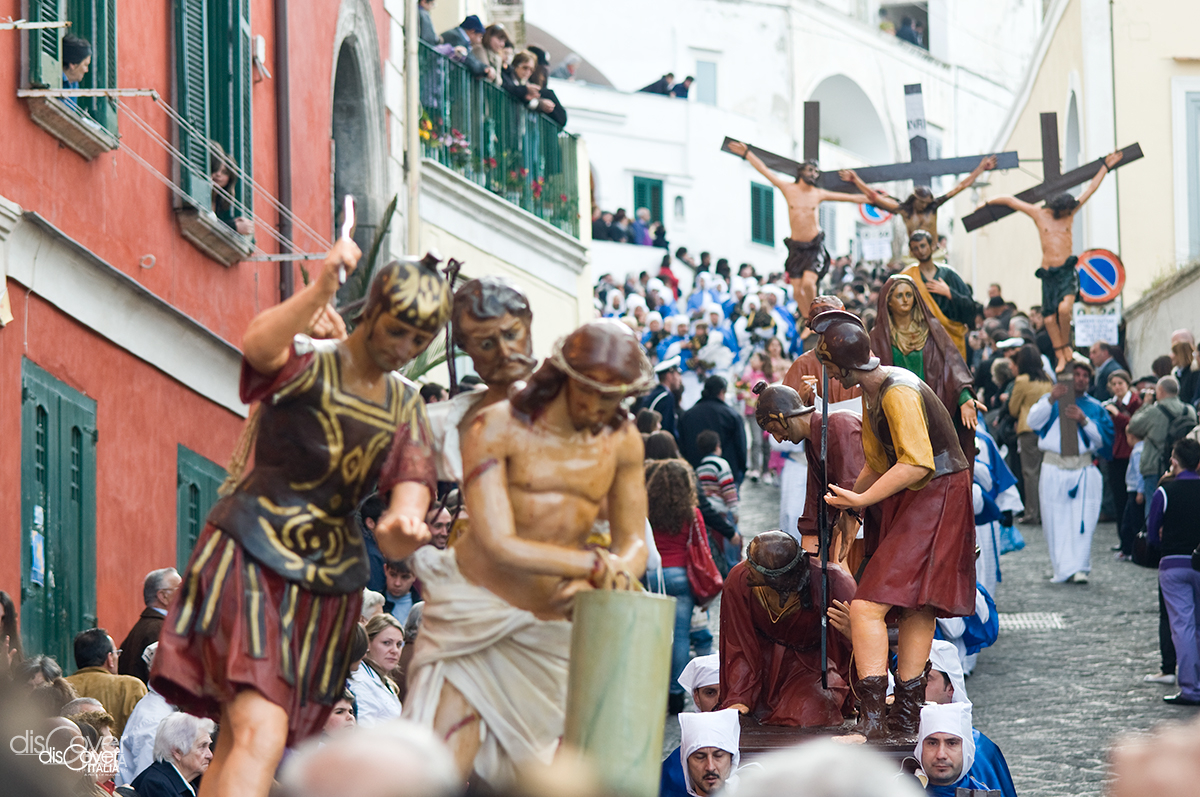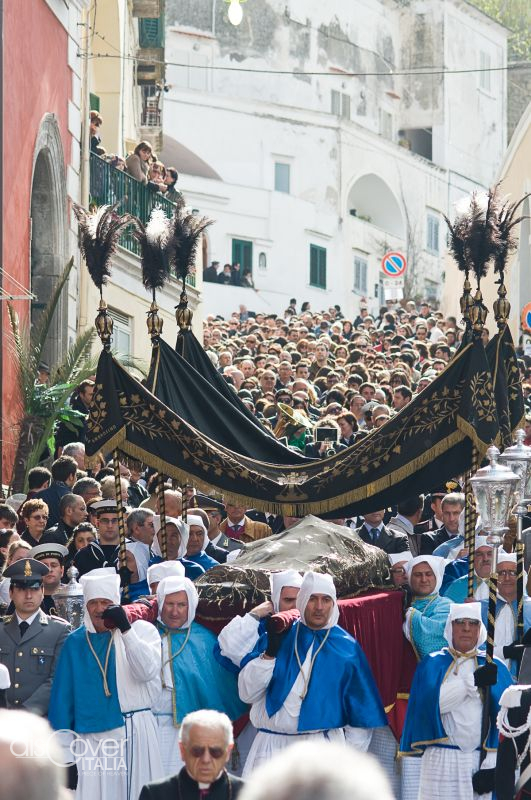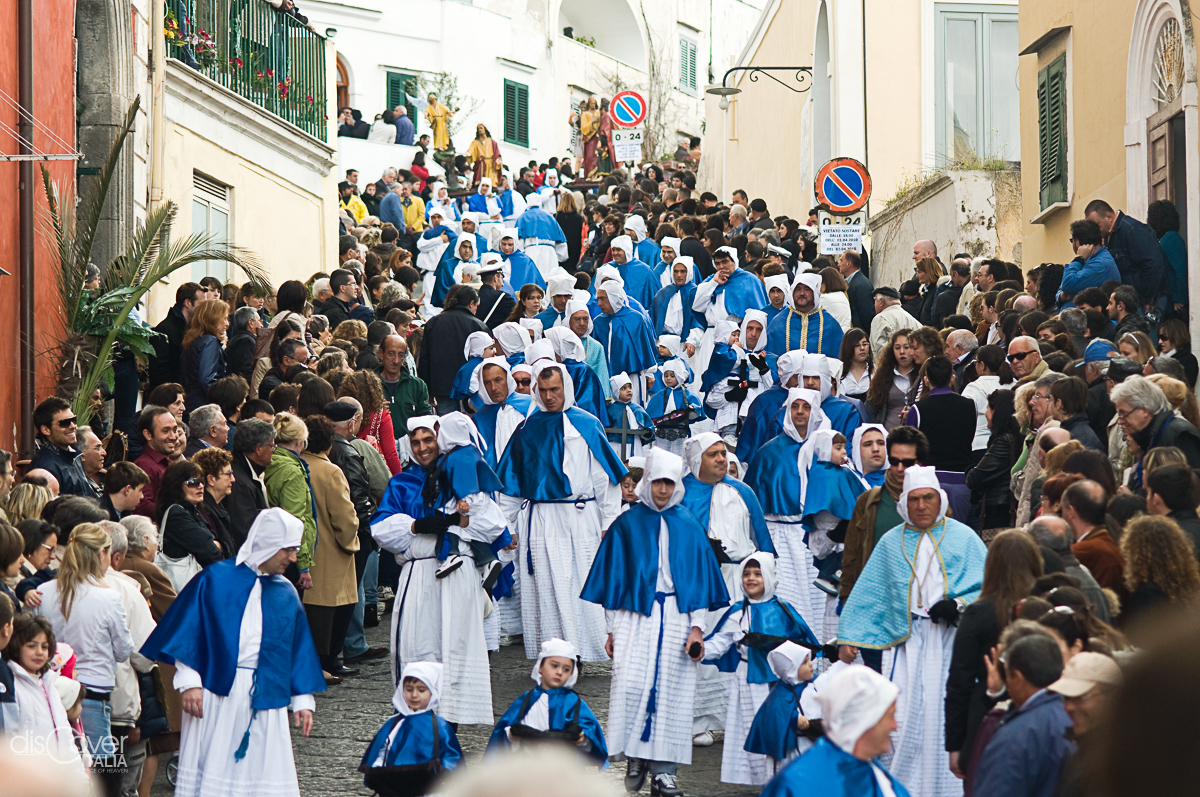It is one of the strongest sensorial emotions that every inhabitant of Procida carries with him from early age, wherever he is.

It is hard to define it in words, that unmistakable, evocative, touching sound like the indissoluble bond with one's land. A unique sound that resembles no other and doesn’t recall musical notes, but contains faith, historical stratifications and cultural contaminations, a sense of belonging and a spirit of community. A sound like a scream: of pain, of the dying Christ; of despair, of the followers who participate in that death; of alert, for all the people called to participate in the collective rite. When the night still dresses the sky, but everyone in the hundred-colored houses is awake, waiting to hear it, moved and busy, because that is the "call" to the most solemn and demanding day of the year, Good Friday, which for three centuries has been identified with the Procession of the Mysteries announced by the sound of the trumpet.

Forty days of rehearsals
To get to the call of the sleepless night of Holy Thursday, it takes all the “Quaresima”(Lent). For forty days, every evening, men who will have the great honor of emitting the right sound are going to train in isolated places next to the sea, companion of every adventure, in the silence that only that strange instrument is allowed to break. The achievement is difficult, it requires great commitment, humility, passion. Because Procida’s trumpet, perhaps an evolution of the shell originally used, is special in shape and features, without keys, unique item, impossible to find anywhere else. And its vibrations are incomparable, ancestral like their meanings running through history and linked to much older rites than the solemn Easter appointment.
The training of the four players is a slow path full of tests, a path of faith and constancy, until the day of the most demanding test of all, when they will have to demonstrate their skill in blowing with the necessary force to excite the crowd. A handful of seconds of extraordinary intensity for a sound destined to be indelibly pinned in the memory.
Only men play, always. They are entrusted with the instrument of the Congrega dei Turchini(coven of Turchini), jealously guarded in Terra Murata, where it all begins, in the rest of the year. And it is the eldest of the group who in his house provides the ritual washing of the trumpet, a week before the fateful night. With milk, vinegar and hunting pellets prepared by his wife, which he will then have to dry thoroughly in the sun or, in case of bad weather, in a wood-fired oven that has just been turned on and off. For a few days there is to recover the sound, after washing, but on Holy Wednesday the instrument remains silent, until the night of the "call".
The Mysteries
Lent is also the time of preparation of the Mysteries that will characterize the Procession that takes its name from them. It is a phase of choral participation, strengthening the identity of the community and the bond between the generations. For days, every free moment is dedicated to the design and realization of the "Mysteries", behind the doors inside ancient buildings, where papier-mache and other poor materials are worked with great vigor to model the large tables, becoming more and more challenging over the years. Between forty and sixty sets, inspired by the reading of the Gospels and the Old Testament and by the creativity of the designers accepting every year, the challenge of innovation in the wake of respect for the Scriptures and traditions. Highly motivated teams of builders, used to overcome any difficulties, making the best out of everyone's contribution and the skills of each, to give more and more prestige to the event that represents their island like no other.
Holy Thursday
While still completing the Mysteries, on Holy Thursday, the Archconfraternity of the Whites of the Blessed Sacrament, founded in 1581 by Cardinal Iñigo d’Avalos, organizes the celebration "In coena Domini". The rite of the washing of the feet is followed by the fraternal agape, in which twelve confreres participate opening the cortege of the Twelve Apostles, preceded by a Centurion and formed by confreres accompanied by the spiritual father "in nigris", all with their faces covered, a crown of thorns on the head and a black cross on the shoulder. The cortege proceeds through the streets of the island and stops in every parish church to adore the Blessed Sacrament. In the evening, from every church, the song of "I adore you" rises to seal an intense day that prepares the waiting.
The rituals of preparation of the Statues
There are two main statues of the Good Friday procession, the dead Christ and the Addolorata.

The wooden statue of Christ, with an extraordinarily expressive face of the suffering suffered on the cross, is from 1728, work of the Naepolitan sculptor, specialized in sacred subjects, Carmine Lantriceni. It belongs to the ancient Congrega of the Immaculate Conception, founded in 1588 on the initiative of the Jesuit Fathers and called “Dei Turchini”(of the Turquoise friars), because of that color is the silk "mozzetta" (a particular cape used by religious man) worn by the brothers on the white robe, which has always been the organizer of the procession. When in 1892 the Congrega left its historical seat in Terra Murata, to move to the new church of San Tommaso d'Aquino, the wooden Christ was also moved and has been kept there the entire year since then, except for the Easter outing. Preceded by a ritual ceremony, entrusted to five women. The wooden statue is placed on a marble bed covered with a red fabric. The statue is dusted with brushes starting from the feet up to the face, then cleaned with cinnamon oil following the same ritual. Everything that came into direct contact with the venerated work of art is carefully preserved. Then the group focuses on praying.
On the last Saturday of Lent, the same women had dedicated themselves to dressing the statue of "Addolorata", which dates back to the nineteenth century. Even in that case, the ritual consists of gestures handed down from generation to generation. In the sacristy, the statue is delicately dusted and then covered with finely embroidered robes. A group of men then enthrones on the high altar of the church, on the throne dressed in red fabric, where it will remain until the time of the procession.

From Terra Murata when it is still dark
Heir, like others in Campania, of consolidated traditions of the Semana Santa di Spagna transferred to Naples during the long period of Spanish domination, Procida Procession is documented for the first time in 1693 and defined as “processio mortificationis”. A ceremony with a strong emotional impact, considering that it was deemed necessary to prohibit the participation of minors under eighteen years of age. Decisive for the reorganization of the procession was the arrival on the island of the statue of the Dead Christ, but its current configuration began to develop only later with the addition of the Mysteries, increasingly elaborate symbolic representations of scenes from the Bible.
It all begins, when it is still dark, to the sound of the trumpet alternating with three drumbeats, the sound accompanying those condemned to death in ancient Rome, here announce to the islanders the moment of vigil to prepare for the event of the new day. In Terra Murata, the oldest hamlet, the crowd prays intensely while in the square in front of the abbey of San Michele, from the places where they were built, the Mysteries arrive, revealed for the first time to the public, and from all over the island over two thousand participants gather in robes, some even very old, which they will wear during the procession.
On the streets of the island
At dawn it is the eldest brother of the Turchini who dictates the order of the procession aloud based on the theme of the year, calling all the participants by name. The trumpet and the drum set the rhythm for the slow pace of the endless row, just behind the banners of the Covenants and the crown of thorns. Then, the Mysteries, moved with great devotion by the porters along the path that, from the top of Terra Murata, crosses the island descending towards the sea, with some intermediate stop. Carried on shoulders, statues of religious subjects proceed solemnly. Behind that of the Addolorata, in the arms of a parent, dressed in Turchini tunic and mozzetta, the "little angels" parade, little ones of one or two years old at their first Procession, dressed in black embroidered in gold, like the funeral mantle of the Madonna. Next, the older children with flowers. And towards the end of the procession, the statue from which every eye is touched: Dead Christ, with the pallium, the funeral canopy. The procession is closed by the musical band intoning funeral marches.
It takes at least three hours to complete the route, which always had Marina Grande as its arrival point, ideal place of reunion with the sea, where the Mysteries remain on display.
The statues, on the other hand, are brought back to San Michele in the afternoon, while in the evening, in the glow of the torches, the statue of Christ is taken back to the church of San Tommaso d’Aquino, seat of the Turchini. The last suggestion of a day intensely lived, moment by moment, by the people of Procida. That will keep sounds, atmospheres and emotions in their memories. Among the most precious memories to be kept with care.



Comments powered by CComment